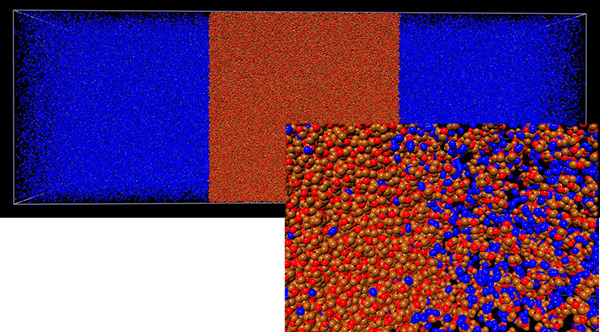MATERIALS SCIENCE AND CHEMISTRY
Molecular Simulations to Understand Droplets Under Extreme Conditions in Combustion Chambers
Principal Investigator:
Jadran Vrabec
Affiliation:
Universität Paderborn
Local Project ID:
MMHBF
HPC Platform used:
Hermit of HLRS
Date published:
Droplets play a crucial role in many fields of science and technology. A fundamental understanding of droplet dynamics is essential for the optimization of technical systems or the better prediction of natural phenomena. Particularly in energy technology, many processes that are associated with droplets occur under extreme conditions of temperature or pressure, e.g. flash boiling in combustion chambers. Such processes are actively being used although striking gaps remain in the essential understanding of droplet dynamics.
At the same time, thermodynamic data for most technically interesting systems are still scarce or even unavailable despite the large experimental effort that was invested over the last century into their measurement. This particularly applies to mixtures of two or more components and systems under extreme conditions.
In contrast to phenomenological methods, molecular modelling and simulation is based on a sound physical foundation and is therefore well suited for the prediction of such thermodynamicproperties and processes under extreme ambient conditions. Jadran Vrabec and his chair of Thermodynamics and Energy Technology at the University of Paderborn is working to close this gap for a model fuel (consisting of acetone, nitrogen and oxygen), using the excellent predictive power of molecular modeling and simulation.
Simulations of droplet interfaces are carried out, focusing on high temperatures close to the critical point of acetone. Thereby its behavior on the molecular level is studied yielding important thermodynamic properties such as the surface tension. The results are used in the SFB-TRR 75 ("Droplet dynamics under extreme ambient conditions") as reference values in larger scale models, e.g. computational fluid dynamics.
Due to the extremely large number of molecules even in a single droplet, only subdomains of the interfaces can be investigated with a reasonable computational effort. The direct simulation of phase boundaries requires at least a volume embracing the thickness of the interface, which itself can be quite large in molecular terms. Also the simulation time has to be rather long based on equilibration processes. Together, this leads to very demanding simulations for which the necessary computing can only be provided by modern supercomputers such as the petascale system Hermit of GCS centre HLRS Stuttgart.

Molecular dynamics simulation of acetone in a nitrogen atmosphere under high pressure.
Copyright: © Thermodynamics and Energy Technology, Universität Paderborn
Scientific Contact:
Prof. Dr.-Ing. Jadran Vrabec
Thermodynamics and Energy Technology
Universität Paderborn
Warburger Str. 100, D-33098 Paderborn
jadran.vrabec@upb.de